Reflection on Experience of Interprofessional Teamwork in Healthcare
VerifiedAdded on 2023/06/09
|15
|4559
|463
Journal and Reflective Writing
AI Summary
This reflective essay provides a student's account of their experience working within an interprofessional team in a cardiovascular ward. The essay begins with an introduction to interprofessional collaboration, highlighting its benefits such as improved patient outcomes and the importance of interprofessional learning for healthcare students. The student then describes their experience, detailing interactions with various healthcare professionals and the supportive environment provided by a vascular consultant. The essay uses Gibb's reflective model to structure the analysis, covering descriptions of the experience, feelings, evaluation, analysis, and action plans. The student reflects on the initial nervousness, the positive impact of the consultant's mentorship, and the importance of professionalism, role clarity, and effective communication within the team. The analysis section emphasizes the difference between multi-professional and interprofessional teamwork and the relevance of Belbin's team role theory. The student concludes by summarizing the key lessons learned, including the importance of collaboration, clear roles, and effective communication in delivering quality patient care, offering insights into how the experience will shape future practice.
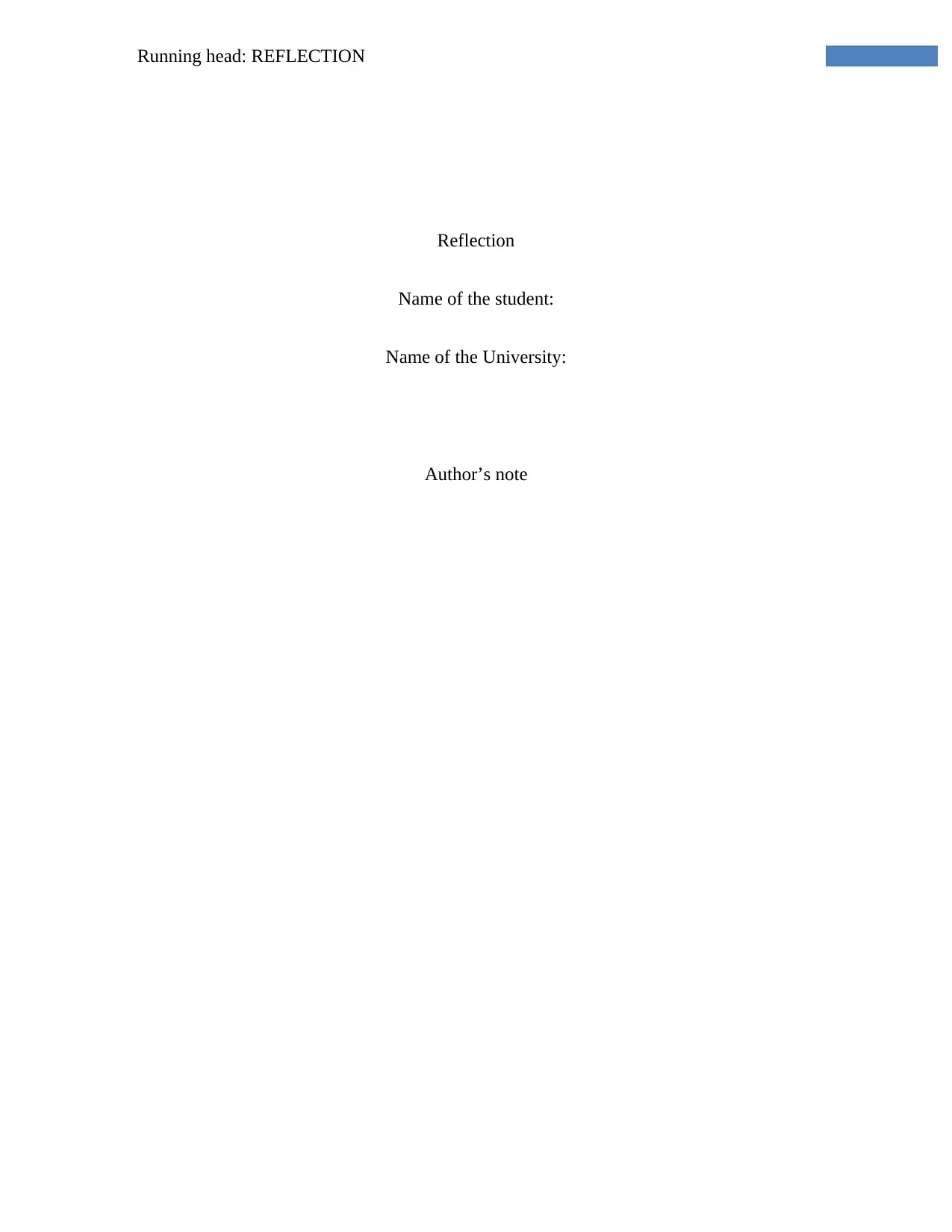
Running head: REFLECTION
Reflection
Name of the student:
Name of the University:
Author’s note
Reflection
Name of the student:
Name of the University:
Author’s note
Paraphrase This Document
Need a fresh take? Get an instant paraphrase of this document with our AI Paraphraser
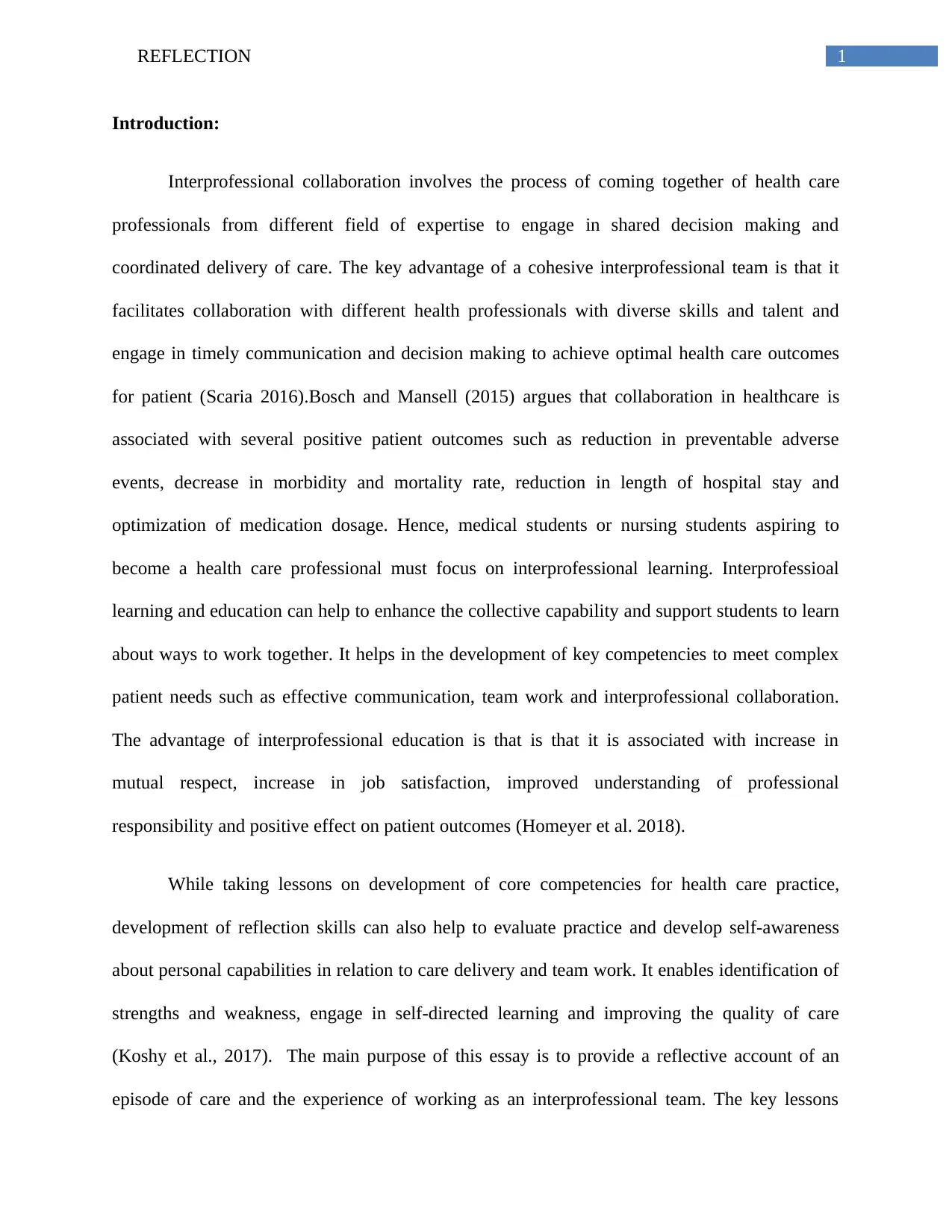
1REFLECTION
Introduction:
Interprofessional collaboration involves the process of coming together of health care
professionals from different field of expertise to engage in shared decision making and
coordinated delivery of care. The key advantage of a cohesive interprofessional team is that it
facilitates collaboration with different health professionals with diverse skills and talent and
engage in timely communication and decision making to achieve optimal health care outcomes
for patient (Scaria 2016).Bosch and Mansell (2015) argues that collaboration in healthcare is
associated with several positive patient outcomes such as reduction in preventable adverse
events, decrease in morbidity and mortality rate, reduction in length of hospital stay and
optimization of medication dosage. Hence, medical students or nursing students aspiring to
become a health care professional must focus on interprofessional learning. Interprofessioal
learning and education can help to enhance the collective capability and support students to learn
about ways to work together. It helps in the development of key competencies to meet complex
patient needs such as effective communication, team work and interprofessional collaboration.
The advantage of interprofessional education is that is that it is associated with increase in
mutual respect, increase in job satisfaction, improved understanding of professional
responsibility and positive effect on patient outcomes (Homeyer et al. 2018).
While taking lessons on development of core competencies for health care practice,
development of reflection skills can also help to evaluate practice and develop self-awareness
about personal capabilities in relation to care delivery and team work. It enables identification of
strengths and weakness, engage in self-directed learning and improving the quality of care
(Koshy et al., 2017). The main purpose of this essay is to provide a reflective account of an
episode of care and the experience of working as an interprofessional team. The key lessons
Introduction:
Interprofessional collaboration involves the process of coming together of health care
professionals from different field of expertise to engage in shared decision making and
coordinated delivery of care. The key advantage of a cohesive interprofessional team is that it
facilitates collaboration with different health professionals with diverse skills and talent and
engage in timely communication and decision making to achieve optimal health care outcomes
for patient (Scaria 2016).Bosch and Mansell (2015) argues that collaboration in healthcare is
associated with several positive patient outcomes such as reduction in preventable adverse
events, decrease in morbidity and mortality rate, reduction in length of hospital stay and
optimization of medication dosage. Hence, medical students or nursing students aspiring to
become a health care professional must focus on interprofessional learning. Interprofessioal
learning and education can help to enhance the collective capability and support students to learn
about ways to work together. It helps in the development of key competencies to meet complex
patient needs such as effective communication, team work and interprofessional collaboration.
The advantage of interprofessional education is that is that it is associated with increase in
mutual respect, increase in job satisfaction, improved understanding of professional
responsibility and positive effect on patient outcomes (Homeyer et al. 2018).
While taking lessons on development of core competencies for health care practice,
development of reflection skills can also help to evaluate practice and develop self-awareness
about personal capabilities in relation to care delivery and team work. It enables identification of
strengths and weakness, engage in self-directed learning and improving the quality of care
(Koshy et al., 2017). The main purpose of this essay is to provide a reflective account of an
episode of care and the experience of working as an interprofessional team. The key lessons
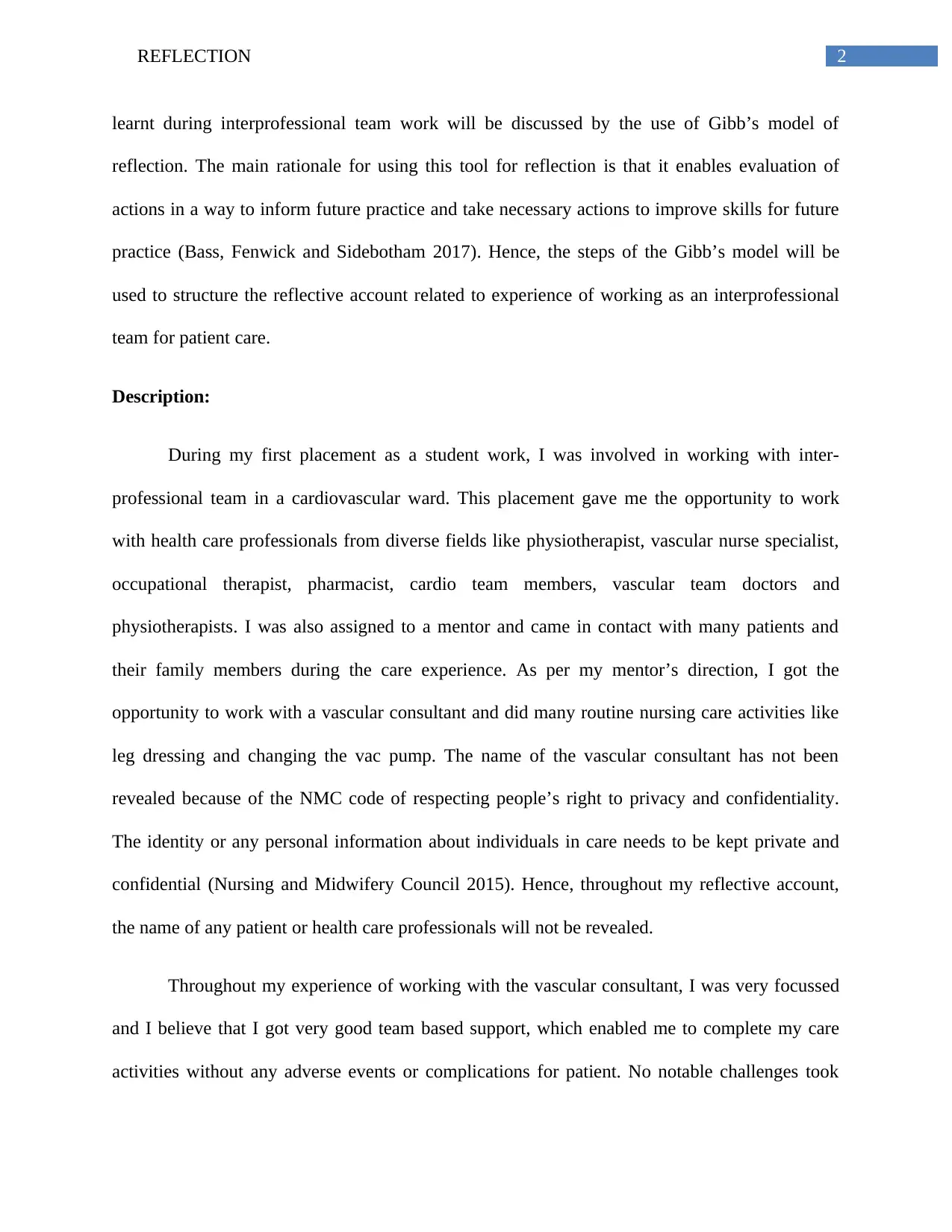
2REFLECTION
learnt during interprofessional team work will be discussed by the use of Gibb’s model of
reflection. The main rationale for using this tool for reflection is that it enables evaluation of
actions in a way to inform future practice and take necessary actions to improve skills for future
practice (Bass, Fenwick and Sidebotham 2017). Hence, the steps of the Gibb’s model will be
used to structure the reflective account related to experience of working as an interprofessional
team for patient care.
Description:
During my first placement as a student work, I was involved in working with inter-
professional team in a cardiovascular ward. This placement gave me the opportunity to work
with health care professionals from diverse fields like physiotherapist, vascular nurse specialist,
occupational therapist, pharmacist, cardio team members, vascular team doctors and
physiotherapists. I was also assigned to a mentor and came in contact with many patients and
their family members during the care experience. As per my mentor’s direction, I got the
opportunity to work with a vascular consultant and did many routine nursing care activities like
leg dressing and changing the vac pump. The name of the vascular consultant has not been
revealed because of the NMC code of respecting people’s right to privacy and confidentiality.
The identity or any personal information about individuals in care needs to be kept private and
confidential (Nursing and Midwifery Council 2015). Hence, throughout my reflective account,
the name of any patient or health care professionals will not be revealed.
Throughout my experience of working with the vascular consultant, I was very focussed
and I believe that I got very good team based support, which enabled me to complete my care
activities without any adverse events or complications for patient. No notable challenges took
learnt during interprofessional team work will be discussed by the use of Gibb’s model of
reflection. The main rationale for using this tool for reflection is that it enables evaluation of
actions in a way to inform future practice and take necessary actions to improve skills for future
practice (Bass, Fenwick and Sidebotham 2017). Hence, the steps of the Gibb’s model will be
used to structure the reflective account related to experience of working as an interprofessional
team for patient care.
Description:
During my first placement as a student work, I was involved in working with inter-
professional team in a cardiovascular ward. This placement gave me the opportunity to work
with health care professionals from diverse fields like physiotherapist, vascular nurse specialist,
occupational therapist, pharmacist, cardio team members, vascular team doctors and
physiotherapists. I was also assigned to a mentor and came in contact with many patients and
their family members during the care experience. As per my mentor’s direction, I got the
opportunity to work with a vascular consultant and did many routine nursing care activities like
leg dressing and changing the vac pump. The name of the vascular consultant has not been
revealed because of the NMC code of respecting people’s right to privacy and confidentiality.
The identity or any personal information about individuals in care needs to be kept private and
confidential (Nursing and Midwifery Council 2015). Hence, throughout my reflective account,
the name of any patient or health care professionals will not be revealed.
Throughout my experience of working with the vascular consultant, I was very focussed
and I believe that I got very good team based support, which enabled me to complete my care
activities without any adverse events or complications for patient. No notable challenges took
⊘ This is a preview!⊘
Do you want full access?
Subscribe today to unlock all pages.

Trusted by 1+ million students worldwide
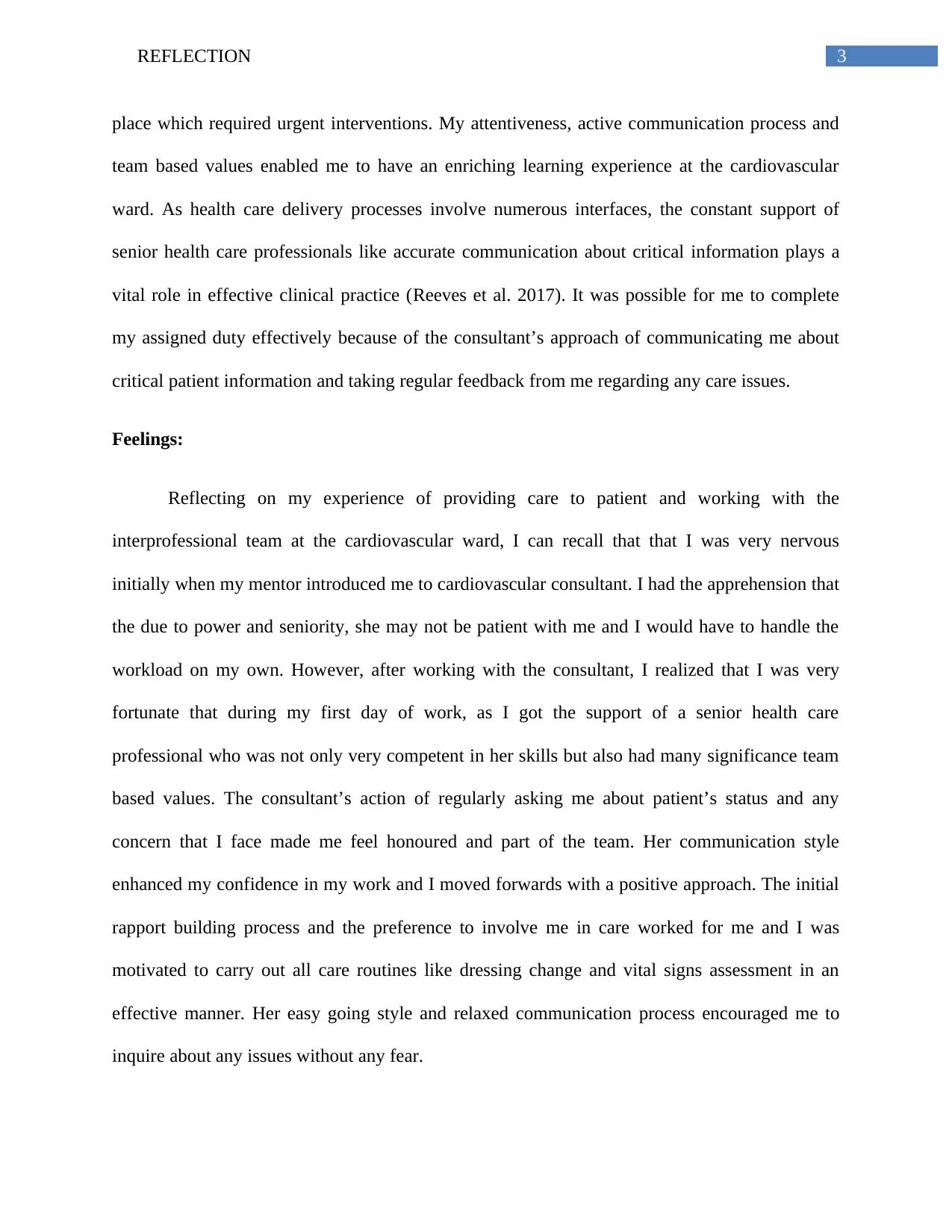
3REFLECTION
place which required urgent interventions. My attentiveness, active communication process and
team based values enabled me to have an enriching learning experience at the cardiovascular
ward. As health care delivery processes involve numerous interfaces, the constant support of
senior health care professionals like accurate communication about critical information plays a
vital role in effective clinical practice (Reeves et al. 2017). It was possible for me to complete
my assigned duty effectively because of the consultant’s approach of communicating me about
critical patient information and taking regular feedback from me regarding any care issues.
Feelings:
Reflecting on my experience of providing care to patient and working with the
interprofessional team at the cardiovascular ward, I can recall that that I was very nervous
initially when my mentor introduced me to cardiovascular consultant. I had the apprehension that
the due to power and seniority, she may not be patient with me and I would have to handle the
workload on my own. However, after working with the consultant, I realized that I was very
fortunate that during my first day of work, as I got the support of a senior health care
professional who was not only very competent in her skills but also had many significance team
based values. The consultant’s action of regularly asking me about patient’s status and any
concern that I face made me feel honoured and part of the team. Her communication style
enhanced my confidence in my work and I moved forwards with a positive approach. The initial
rapport building process and the preference to involve me in care worked for me and I was
motivated to carry out all care routines like dressing change and vital signs assessment in an
effective manner. Her easy going style and relaxed communication process encouraged me to
inquire about any issues without any fear.
place which required urgent interventions. My attentiveness, active communication process and
team based values enabled me to have an enriching learning experience at the cardiovascular
ward. As health care delivery processes involve numerous interfaces, the constant support of
senior health care professionals like accurate communication about critical information plays a
vital role in effective clinical practice (Reeves et al. 2017). It was possible for me to complete
my assigned duty effectively because of the consultant’s approach of communicating me about
critical patient information and taking regular feedback from me regarding any care issues.
Feelings:
Reflecting on my experience of providing care to patient and working with the
interprofessional team at the cardiovascular ward, I can recall that that I was very nervous
initially when my mentor introduced me to cardiovascular consultant. I had the apprehension that
the due to power and seniority, she may not be patient with me and I would have to handle the
workload on my own. However, after working with the consultant, I realized that I was very
fortunate that during my first day of work, as I got the support of a senior health care
professional who was not only very competent in her skills but also had many significance team
based values. The consultant’s action of regularly asking me about patient’s status and any
concern that I face made me feel honoured and part of the team. Her communication style
enhanced my confidence in my work and I moved forwards with a positive approach. The initial
rapport building process and the preference to involve me in care worked for me and I was
motivated to carry out all care routines like dressing change and vital signs assessment in an
effective manner. Her easy going style and relaxed communication process encouraged me to
inquire about any issues without any fear.
Paraphrase This Document
Need a fresh take? Get an instant paraphrase of this document with our AI Paraphraser
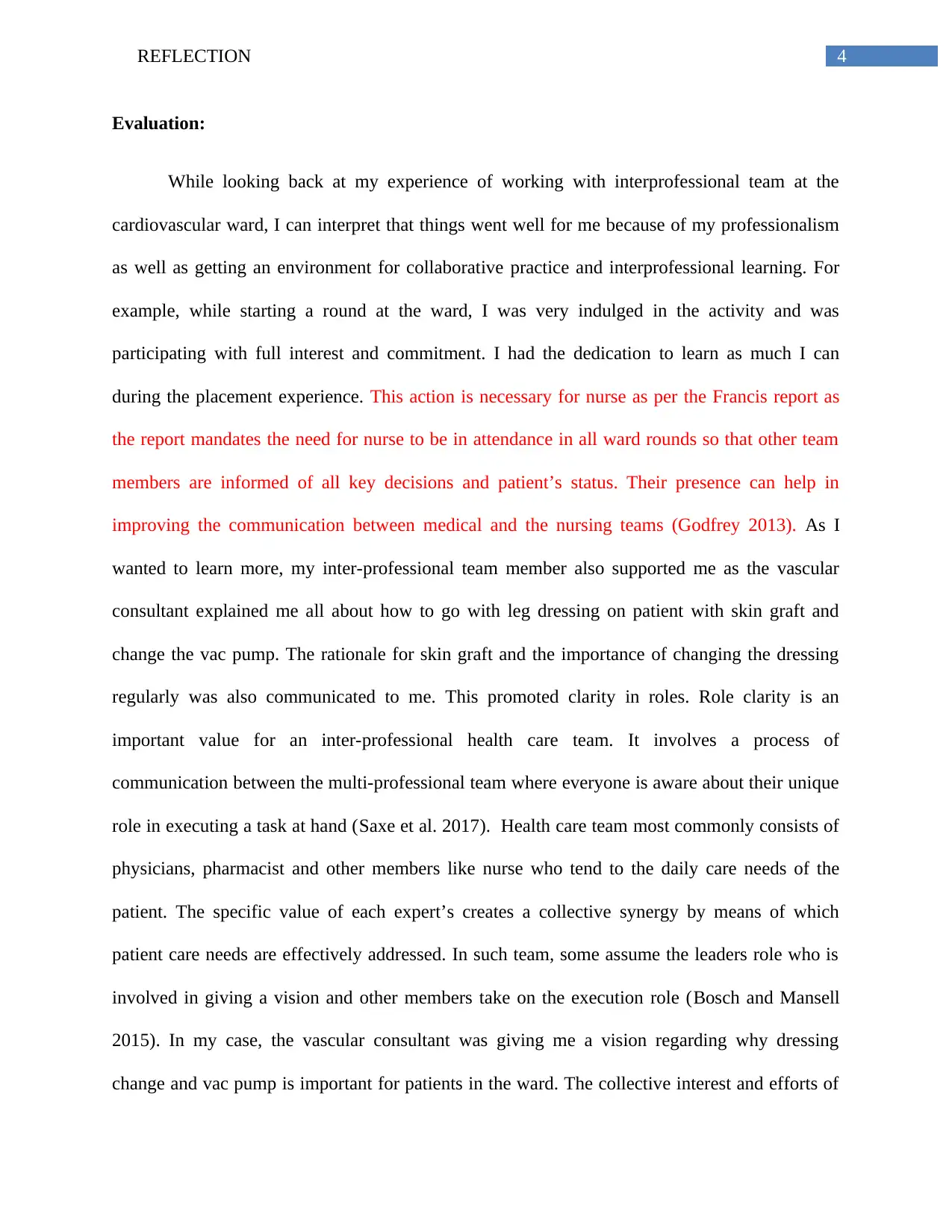
4REFLECTION
Evaluation:
While looking back at my experience of working with interprofessional team at the
cardiovascular ward, I can interpret that things went well for me because of my professionalism
as well as getting an environment for collaborative practice and interprofessional learning. For
example, while starting a round at the ward, I was very indulged in the activity and was
participating with full interest and commitment. I had the dedication to learn as much I can
during the placement experience. This action is necessary for nurse as per the Francis report as
the report mandates the need for nurse to be in attendance in all ward rounds so that other team
members are informed of all key decisions and patient’s status. Their presence can help in
improving the communication between medical and the nursing teams (Godfrey 2013). As I
wanted to learn more, my inter-professional team member also supported me as the vascular
consultant explained me all about how to go with leg dressing on patient with skin graft and
change the vac pump. The rationale for skin graft and the importance of changing the dressing
regularly was also communicated to me. This promoted clarity in roles. Role clarity is an
important value for an inter-professional health care team. It involves a process of
communication between the multi-professional team where everyone is aware about their unique
role in executing a task at hand (Saxe et al. 2017). Health care team most commonly consists of
physicians, pharmacist and other members like nurse who tend to the daily care needs of the
patient. The specific value of each expert’s creates a collective synergy by means of which
patient care needs are effectively addressed. In such team, some assume the leaders role who is
involved in giving a vision and other members take on the execution role (Bosch and Mansell
2015). In my case, the vascular consultant was giving me a vision regarding why dressing
change and vac pump is important for patients in the ward. The collective interest and efforts of
Evaluation:
While looking back at my experience of working with interprofessional team at the
cardiovascular ward, I can interpret that things went well for me because of my professionalism
as well as getting an environment for collaborative practice and interprofessional learning. For
example, while starting a round at the ward, I was very indulged in the activity and was
participating with full interest and commitment. I had the dedication to learn as much I can
during the placement experience. This action is necessary for nurse as per the Francis report as
the report mandates the need for nurse to be in attendance in all ward rounds so that other team
members are informed of all key decisions and patient’s status. Their presence can help in
improving the communication between medical and the nursing teams (Godfrey 2013). As I
wanted to learn more, my inter-professional team member also supported me as the vascular
consultant explained me all about how to go with leg dressing on patient with skin graft and
change the vac pump. The rationale for skin graft and the importance of changing the dressing
regularly was also communicated to me. This promoted clarity in roles. Role clarity is an
important value for an inter-professional health care team. It involves a process of
communication between the multi-professional team where everyone is aware about their unique
role in executing a task at hand (Saxe et al. 2017). Health care team most commonly consists of
physicians, pharmacist and other members like nurse who tend to the daily care needs of the
patient. The specific value of each expert’s creates a collective synergy by means of which
patient care needs are effectively addressed. In such team, some assume the leaders role who is
involved in giving a vision and other members take on the execution role (Bosch and Mansell
2015). In my case, the vascular consultant was giving me a vision regarding why dressing
change and vac pump is important for patients in the ward. The collective interest and efforts of
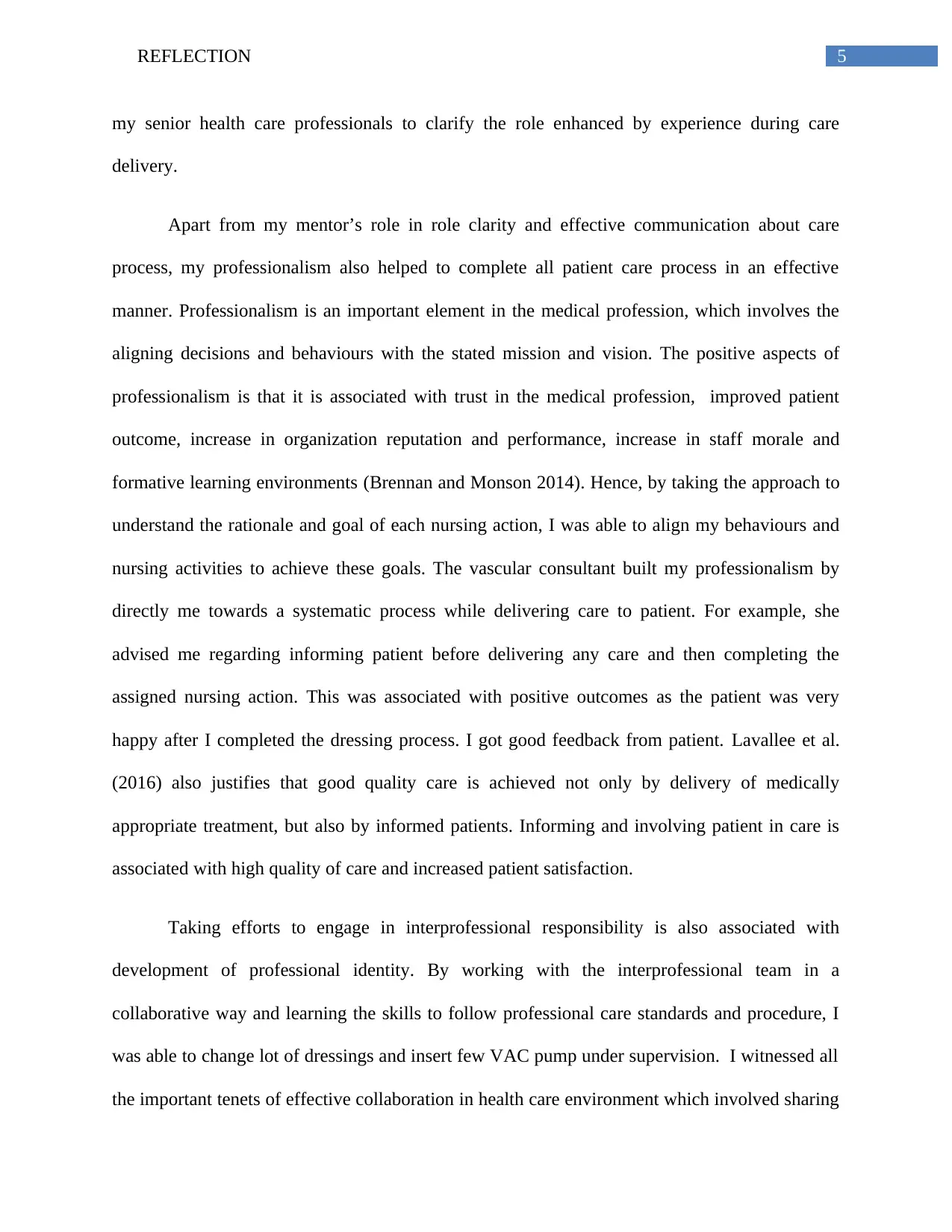
5REFLECTION
my senior health care professionals to clarify the role enhanced by experience during care
delivery.
Apart from my mentor’s role in role clarity and effective communication about care
process, my professionalism also helped to complete all patient care process in an effective
manner. Professionalism is an important element in the medical profession, which involves the
aligning decisions and behaviours with the stated mission and vision. The positive aspects of
professionalism is that it is associated with trust in the medical profession, improved patient
outcome, increase in organization reputation and performance, increase in staff morale and
formative learning environments (Brennan and Monson 2014). Hence, by taking the approach to
understand the rationale and goal of each nursing action, I was able to align my behaviours and
nursing activities to achieve these goals. The vascular consultant built my professionalism by
directly me towards a systematic process while delivering care to patient. For example, she
advised me regarding informing patient before delivering any care and then completing the
assigned nursing action. This was associated with positive outcomes as the patient was very
happy after I completed the dressing process. I got good feedback from patient. Lavallee et al.
(2016) also justifies that good quality care is achieved not only by delivery of medically
appropriate treatment, but also by informed patients. Informing and involving patient in care is
associated with high quality of care and increased patient satisfaction.
Taking efforts to engage in interprofessional responsibility is also associated with
development of professional identity. By working with the interprofessional team in a
collaborative way and learning the skills to follow professional care standards and procedure, I
was able to change lot of dressings and insert few VAC pump under supervision. I witnessed all
the important tenets of effective collaboration in health care environment which involved sharing
my senior health care professionals to clarify the role enhanced by experience during care
delivery.
Apart from my mentor’s role in role clarity and effective communication about care
process, my professionalism also helped to complete all patient care process in an effective
manner. Professionalism is an important element in the medical profession, which involves the
aligning decisions and behaviours with the stated mission and vision. The positive aspects of
professionalism is that it is associated with trust in the medical profession, improved patient
outcome, increase in organization reputation and performance, increase in staff morale and
formative learning environments (Brennan and Monson 2014). Hence, by taking the approach to
understand the rationale and goal of each nursing action, I was able to align my behaviours and
nursing activities to achieve these goals. The vascular consultant built my professionalism by
directly me towards a systematic process while delivering care to patient. For example, she
advised me regarding informing patient before delivering any care and then completing the
assigned nursing action. This was associated with positive outcomes as the patient was very
happy after I completed the dressing process. I got good feedback from patient. Lavallee et al.
(2016) also justifies that good quality care is achieved not only by delivery of medically
appropriate treatment, but also by informed patients. Informing and involving patient in care is
associated with high quality of care and increased patient satisfaction.
Taking efforts to engage in interprofessional responsibility is also associated with
development of professional identity. By working with the interprofessional team in a
collaborative way and learning the skills to follow professional care standards and procedure, I
was able to change lot of dressings and insert few VAC pump under supervision. I witnessed all
the important tenets of effective collaboration in health care environment which involved sharing
⊘ This is a preview!⊘
Do you want full access?
Subscribe today to unlock all pages.

Trusted by 1+ million students worldwide
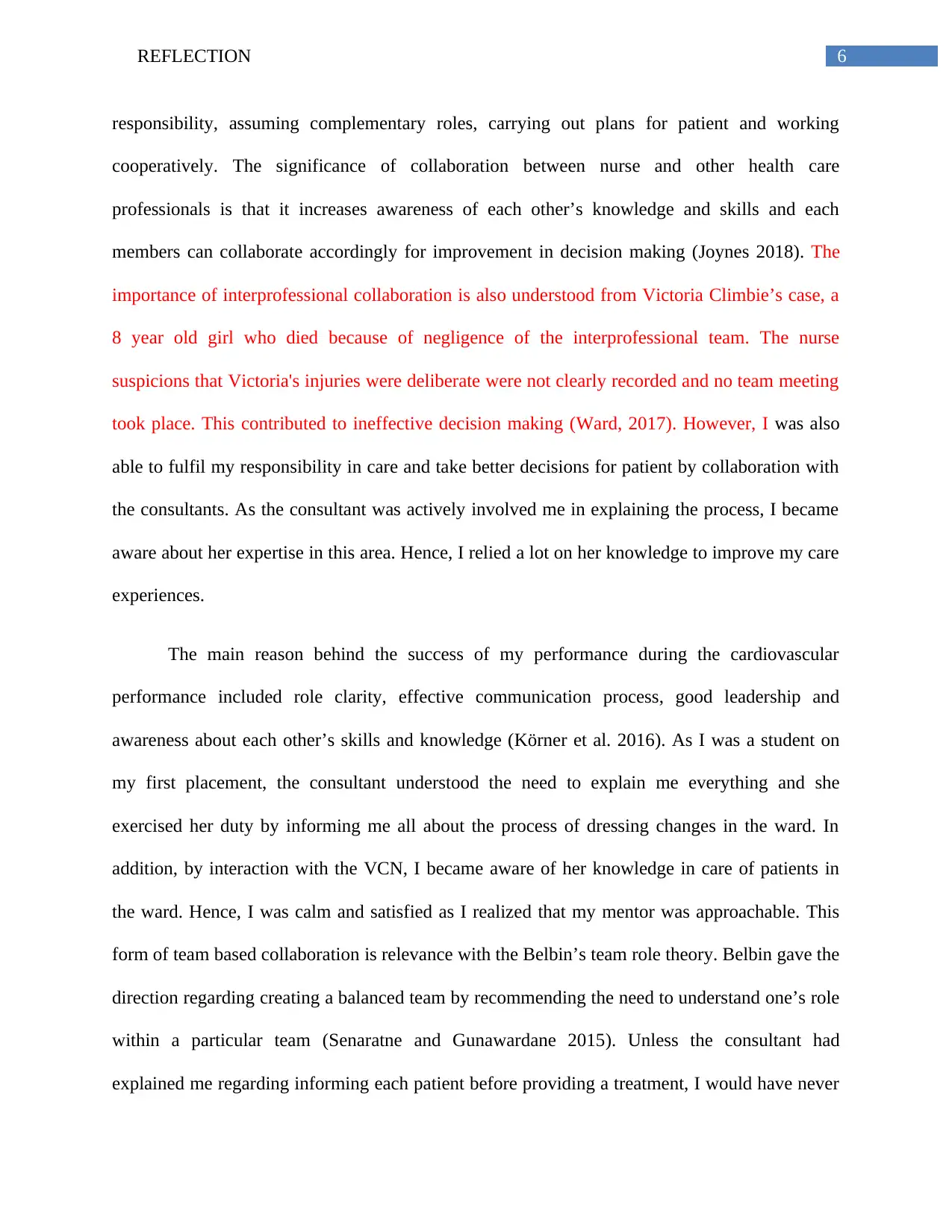
6REFLECTION
responsibility, assuming complementary roles, carrying out plans for patient and working
cooperatively. The significance of collaboration between nurse and other health care
professionals is that it increases awareness of each other’s knowledge and skills and each
members can collaborate accordingly for improvement in decision making (Joynes 2018). The
importance of interprofessional collaboration is also understood from Victoria Climbie’s case, a
8 year old girl who died because of negligence of the interprofessional team. The nurse
suspicions that Victoria's injuries were deliberate were not clearly recorded and no team meeting
took place. This contributed to ineffective decision making (Ward, 2017). However, I was also
able to fulfil my responsibility in care and take better decisions for patient by collaboration with
the consultants. As the consultant was actively involved me in explaining the process, I became
aware about her expertise in this area. Hence, I relied a lot on her knowledge to improve my care
experiences.
The main reason behind the success of my performance during the cardiovascular
performance included role clarity, effective communication process, good leadership and
awareness about each other’s skills and knowledge (Körner et al. 2016). As I was a student on
my first placement, the consultant understood the need to explain me everything and she
exercised her duty by informing me all about the process of dressing changes in the ward. In
addition, by interaction with the VCN, I became aware of her knowledge in care of patients in
the ward. Hence, I was calm and satisfied as I realized that my mentor was approachable. This
form of team based collaboration is relevance with the Belbin’s team role theory. Belbin gave the
direction regarding creating a balanced team by recommending the need to understand one’s role
within a particular team (Senaratne and Gunawardane 2015). Unless the consultant had
explained me regarding informing each patient before providing a treatment, I would have never
responsibility, assuming complementary roles, carrying out plans for patient and working
cooperatively. The significance of collaboration between nurse and other health care
professionals is that it increases awareness of each other’s knowledge and skills and each
members can collaborate accordingly for improvement in decision making (Joynes 2018). The
importance of interprofessional collaboration is also understood from Victoria Climbie’s case, a
8 year old girl who died because of negligence of the interprofessional team. The nurse
suspicions that Victoria's injuries were deliberate were not clearly recorded and no team meeting
took place. This contributed to ineffective decision making (Ward, 2017). However, I was also
able to fulfil my responsibility in care and take better decisions for patient by collaboration with
the consultants. As the consultant was actively involved me in explaining the process, I became
aware about her expertise in this area. Hence, I relied a lot on her knowledge to improve my care
experiences.
The main reason behind the success of my performance during the cardiovascular
performance included role clarity, effective communication process, good leadership and
awareness about each other’s skills and knowledge (Körner et al. 2016). As I was a student on
my first placement, the consultant understood the need to explain me everything and she
exercised her duty by informing me all about the process of dressing changes in the ward. In
addition, by interaction with the VCN, I became aware of her knowledge in care of patients in
the ward. Hence, I was calm and satisfied as I realized that my mentor was approachable. This
form of team based collaboration is relevance with the Belbin’s team role theory. Belbin gave the
direction regarding creating a balanced team by recommending the need to understand one’s role
within a particular team (Senaratne and Gunawardane 2015). Unless the consultant had
explained me regarding informing each patient before providing a treatment, I would have never
Paraphrase This Document
Need a fresh take? Get an instant paraphrase of this document with our AI Paraphraser
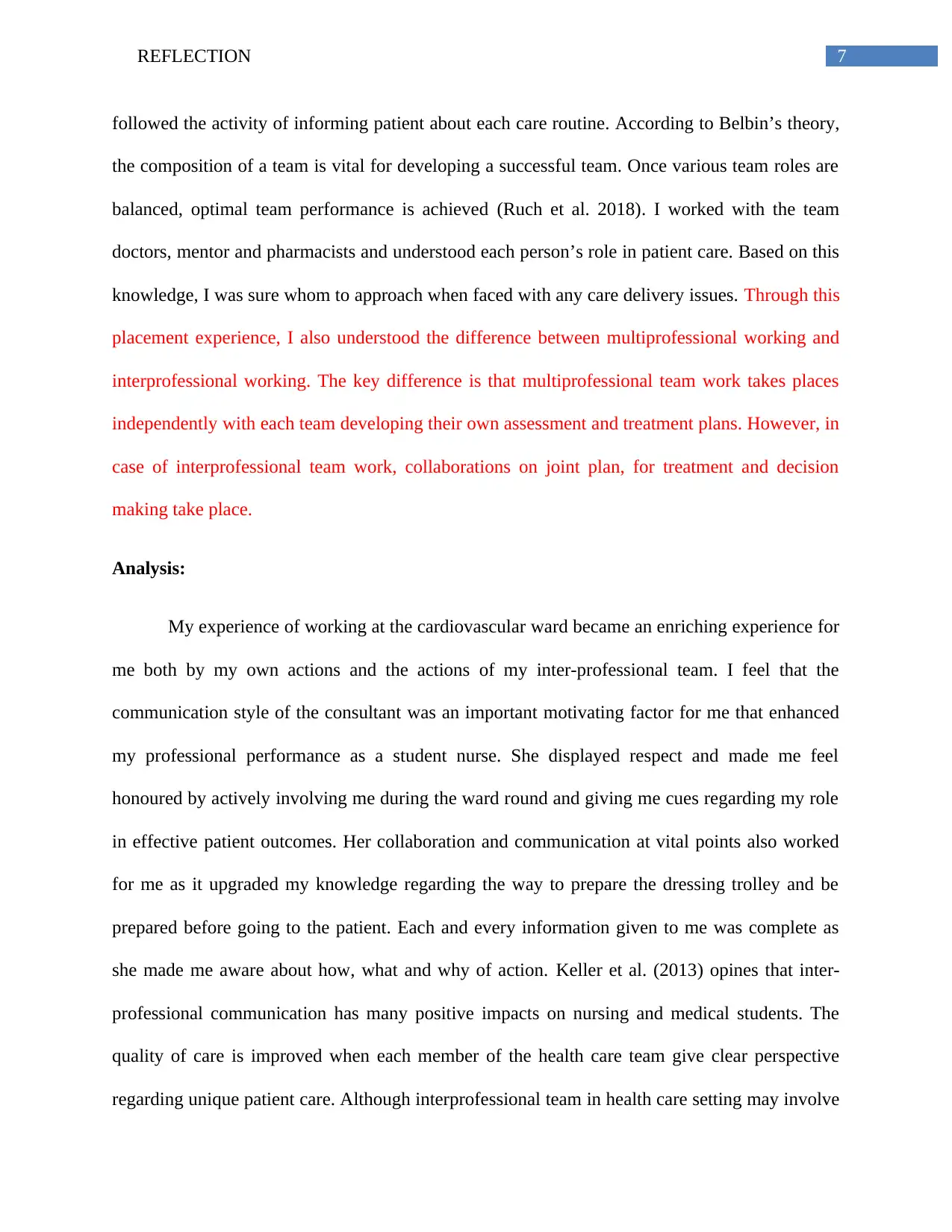
7REFLECTION
followed the activity of informing patient about each care routine. According to Belbin’s theory,
the composition of a team is vital for developing a successful team. Once various team roles are
balanced, optimal team performance is achieved (Ruch et al. 2018). I worked with the team
doctors, mentor and pharmacists and understood each person’s role in patient care. Based on this
knowledge, I was sure whom to approach when faced with any care delivery issues. Through this
placement experience, I also understood the difference between multiprofessional working and
interprofessional working. The key difference is that multiprofessional team work takes places
independently with each team developing their own assessment and treatment plans. However, in
case of interprofessional team work, collaborations on joint plan, for treatment and decision
making take place.
Analysis:
My experience of working at the cardiovascular ward became an enriching experience for
me both by my own actions and the actions of my inter-professional team. I feel that the
communication style of the consultant was an important motivating factor for me that enhanced
my professional performance as a student nurse. She displayed respect and made me feel
honoured by actively involving me during the ward round and giving me cues regarding my role
in effective patient outcomes. Her collaboration and communication at vital points also worked
for me as it upgraded my knowledge regarding the way to prepare the dressing trolley and be
prepared before going to the patient. Each and every information given to me was complete as
she made me aware about how, what and why of action. Keller et al. (2013) opines that inter-
professional communication has many positive impacts on nursing and medical students. The
quality of care is improved when each member of the health care team give clear perspective
regarding unique patient care. Although interprofessional team in health care setting may involve
followed the activity of informing patient about each care routine. According to Belbin’s theory,
the composition of a team is vital for developing a successful team. Once various team roles are
balanced, optimal team performance is achieved (Ruch et al. 2018). I worked with the team
doctors, mentor and pharmacists and understood each person’s role in patient care. Based on this
knowledge, I was sure whom to approach when faced with any care delivery issues. Through this
placement experience, I also understood the difference between multiprofessional working and
interprofessional working. The key difference is that multiprofessional team work takes places
independently with each team developing their own assessment and treatment plans. However, in
case of interprofessional team work, collaborations on joint plan, for treatment and decision
making take place.
Analysis:
My experience of working at the cardiovascular ward became an enriching experience for
me both by my own actions and the actions of my inter-professional team. I feel that the
communication style of the consultant was an important motivating factor for me that enhanced
my professional performance as a student nurse. She displayed respect and made me feel
honoured by actively involving me during the ward round and giving me cues regarding my role
in effective patient outcomes. Her collaboration and communication at vital points also worked
for me as it upgraded my knowledge regarding the way to prepare the dressing trolley and be
prepared before going to the patient. Each and every information given to me was complete as
she made me aware about how, what and why of action. Keller et al. (2013) opines that inter-
professional communication has many positive impacts on nursing and medical students. The
quality of care is improved when each member of the health care team give clear perspective
regarding unique patient care. Although interprofessional team in health care setting may involve
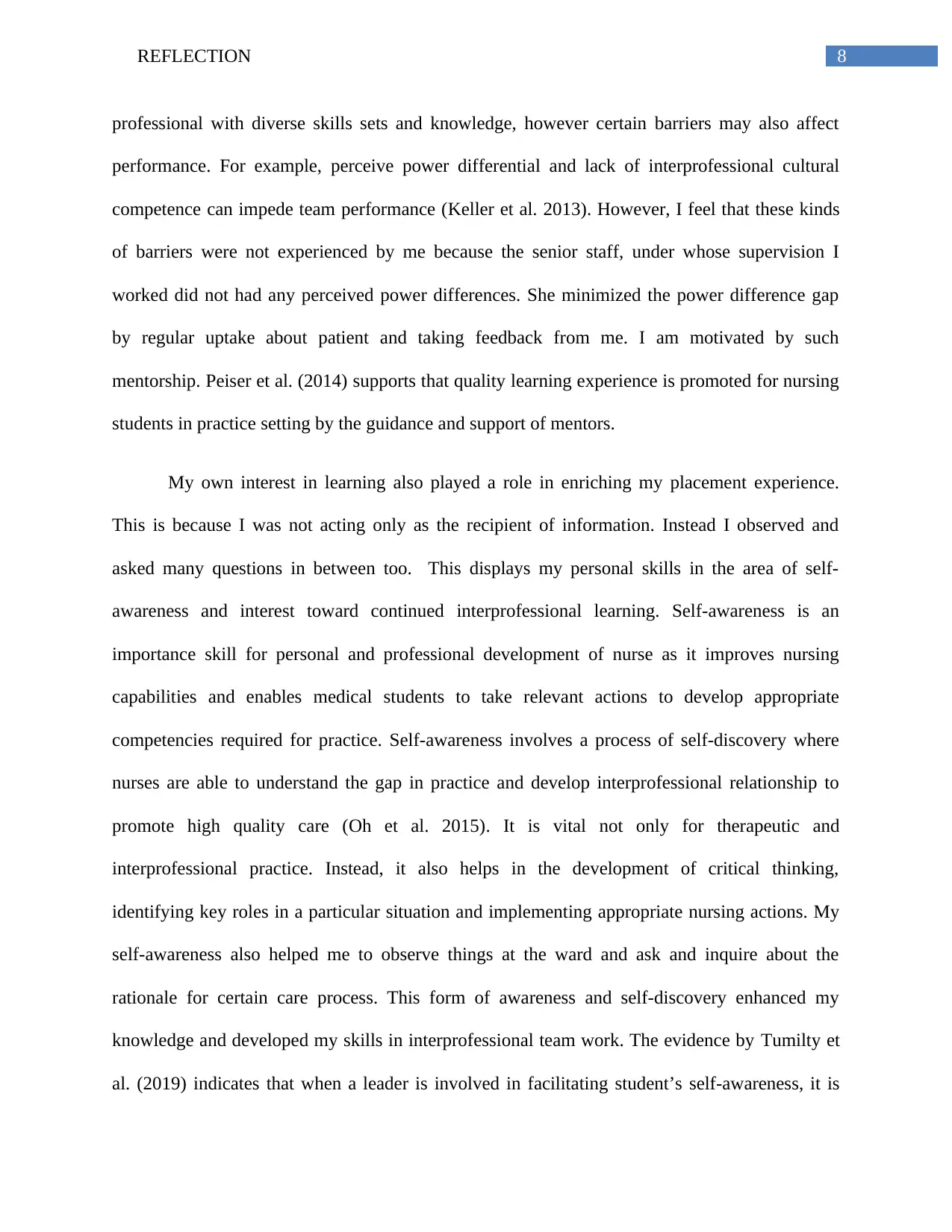
8REFLECTION
professional with diverse skills sets and knowledge, however certain barriers may also affect
performance. For example, perceive power differential and lack of interprofessional cultural
competence can impede team performance (Keller et al. 2013). However, I feel that these kinds
of barriers were not experienced by me because the senior staff, under whose supervision I
worked did not had any perceived power differences. She minimized the power difference gap
by regular uptake about patient and taking feedback from me. I am motivated by such
mentorship. Peiser et al. (2014) supports that quality learning experience is promoted for nursing
students in practice setting by the guidance and support of mentors.
My own interest in learning also played a role in enriching my placement experience.
This is because I was not acting only as the recipient of information. Instead I observed and
asked many questions in between too. This displays my personal skills in the area of self-
awareness and interest toward continued interprofessional learning. Self-awareness is an
importance skill for personal and professional development of nurse as it improves nursing
capabilities and enables medical students to take relevant actions to develop appropriate
competencies required for practice. Self-awareness involves a process of self-discovery where
nurses are able to understand the gap in practice and develop interprofessional relationship to
promote high quality care (Oh et al. 2015). It is vital not only for therapeutic and
interprofessional practice. Instead, it also helps in the development of critical thinking,
identifying key roles in a particular situation and implementing appropriate nursing actions. My
self-awareness also helped me to observe things at the ward and ask and inquire about the
rationale for certain care process. This form of awareness and self-discovery enhanced my
knowledge and developed my skills in interprofessional team work. The evidence by Tumilty et
al. (2019) indicates that when a leader is involved in facilitating student’s self-awareness, it is
professional with diverse skills sets and knowledge, however certain barriers may also affect
performance. For example, perceive power differential and lack of interprofessional cultural
competence can impede team performance (Keller et al. 2013). However, I feel that these kinds
of barriers were not experienced by me because the senior staff, under whose supervision I
worked did not had any perceived power differences. She minimized the power difference gap
by regular uptake about patient and taking feedback from me. I am motivated by such
mentorship. Peiser et al. (2014) supports that quality learning experience is promoted for nursing
students in practice setting by the guidance and support of mentors.
My own interest in learning also played a role in enriching my placement experience.
This is because I was not acting only as the recipient of information. Instead I observed and
asked many questions in between too. This displays my personal skills in the area of self-
awareness and interest toward continued interprofessional learning. Self-awareness is an
importance skill for personal and professional development of nurse as it improves nursing
capabilities and enables medical students to take relevant actions to develop appropriate
competencies required for practice. Self-awareness involves a process of self-discovery where
nurses are able to understand the gap in practice and develop interprofessional relationship to
promote high quality care (Oh et al. 2015). It is vital not only for therapeutic and
interprofessional practice. Instead, it also helps in the development of critical thinking,
identifying key roles in a particular situation and implementing appropriate nursing actions. My
self-awareness also helped me to observe things at the ward and ask and inquire about the
rationale for certain care process. This form of awareness and self-discovery enhanced my
knowledge and developed my skills in interprofessional team work. The evidence by Tumilty et
al. (2019) indicates that when a leader is involved in facilitating student’s self-awareness, it is
⊘ This is a preview!⊘
Do you want full access?
Subscribe today to unlock all pages.

Trusted by 1+ million students worldwide
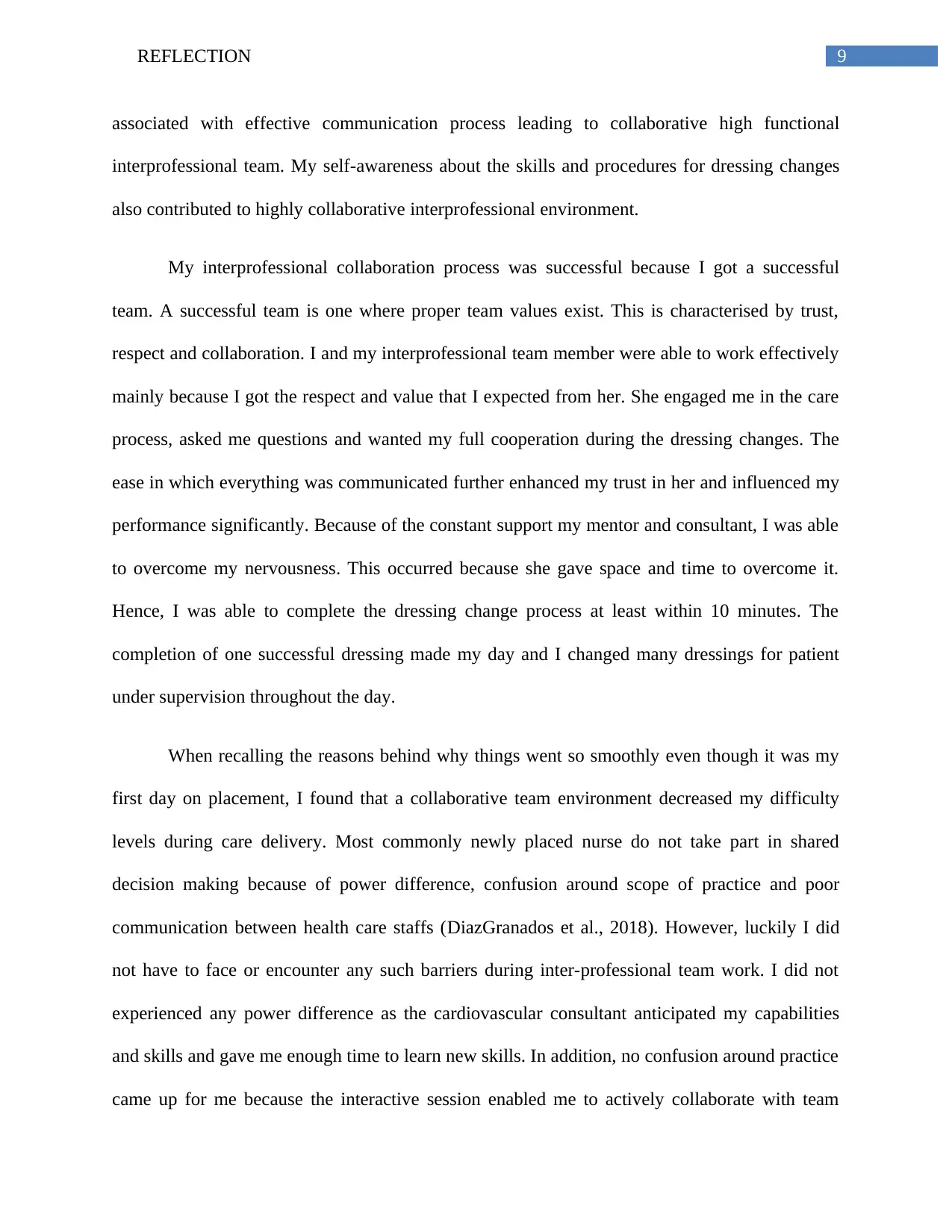
9REFLECTION
associated with effective communication process leading to collaborative high functional
interprofessional team. My self-awareness about the skills and procedures for dressing changes
also contributed to highly collaborative interprofessional environment.
My interprofessional collaboration process was successful because I got a successful
team. A successful team is one where proper team values exist. This is characterised by trust,
respect and collaboration. I and my interprofessional team member were able to work effectively
mainly because I got the respect and value that I expected from her. She engaged me in the care
process, asked me questions and wanted my full cooperation during the dressing changes. The
ease in which everything was communicated further enhanced my trust in her and influenced my
performance significantly. Because of the constant support my mentor and consultant, I was able
to overcome my nervousness. This occurred because she gave space and time to overcome it.
Hence, I was able to complete the dressing change process at least within 10 minutes. The
completion of one successful dressing made my day and I changed many dressings for patient
under supervision throughout the day.
When recalling the reasons behind why things went so smoothly even though it was my
first day on placement, I found that a collaborative team environment decreased my difficulty
levels during care delivery. Most commonly newly placed nurse do not take part in shared
decision making because of power difference, confusion around scope of practice and poor
communication between health care staffs (DiazGranados et al., 2018). However, luckily I did
not have to face or encounter any such barriers during inter-professional team work. I did not
experienced any power difference as the cardiovascular consultant anticipated my capabilities
and skills and gave me enough time to learn new skills. In addition, no confusion around practice
came up for me because the interactive session enabled me to actively collaborate with team
associated with effective communication process leading to collaborative high functional
interprofessional team. My self-awareness about the skills and procedures for dressing changes
also contributed to highly collaborative interprofessional environment.
My interprofessional collaboration process was successful because I got a successful
team. A successful team is one where proper team values exist. This is characterised by trust,
respect and collaboration. I and my interprofessional team member were able to work effectively
mainly because I got the respect and value that I expected from her. She engaged me in the care
process, asked me questions and wanted my full cooperation during the dressing changes. The
ease in which everything was communicated further enhanced my trust in her and influenced my
performance significantly. Because of the constant support my mentor and consultant, I was able
to overcome my nervousness. This occurred because she gave space and time to overcome it.
Hence, I was able to complete the dressing change process at least within 10 minutes. The
completion of one successful dressing made my day and I changed many dressings for patient
under supervision throughout the day.
When recalling the reasons behind why things went so smoothly even though it was my
first day on placement, I found that a collaborative team environment decreased my difficulty
levels during care delivery. Most commonly newly placed nurse do not take part in shared
decision making because of power difference, confusion around scope of practice and poor
communication between health care staffs (DiazGranados et al., 2018). However, luckily I did
not have to face or encounter any such barriers during inter-professional team work. I did not
experienced any power difference as the cardiovascular consultant anticipated my capabilities
and skills and gave me enough time to learn new skills. In addition, no confusion around practice
came up for me because the interactive session enabled me to actively collaborate with team
Paraphrase This Document
Need a fresh take? Get an instant paraphrase of this document with our AI Paraphraser
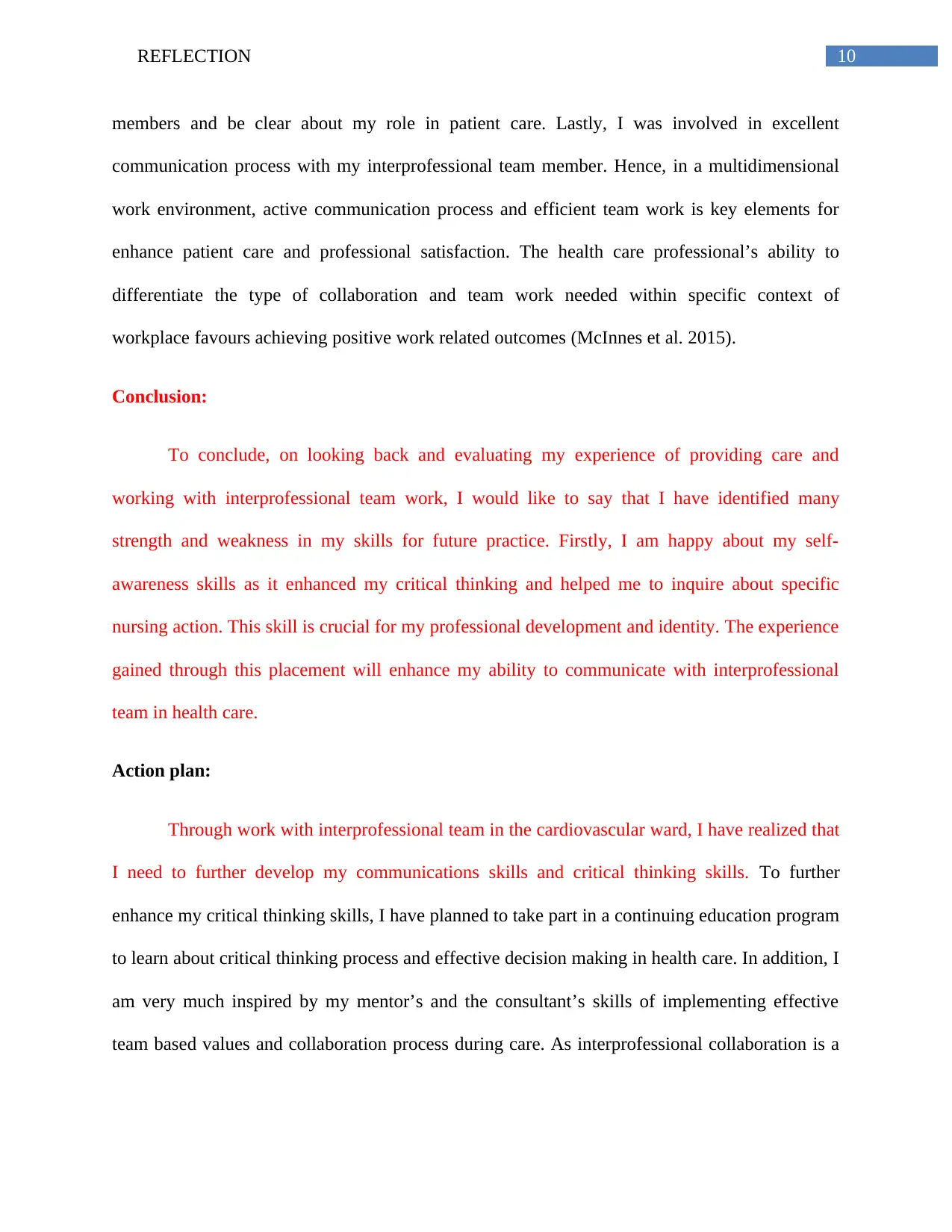
10REFLECTION
members and be clear about my role in patient care. Lastly, I was involved in excellent
communication process with my interprofessional team member. Hence, in a multidimensional
work environment, active communication process and efficient team work is key elements for
enhance patient care and professional satisfaction. The health care professional’s ability to
differentiate the type of collaboration and team work needed within specific context of
workplace favours achieving positive work related outcomes (McInnes et al. 2015).
Conclusion:
To conclude, on looking back and evaluating my experience of providing care and
working with interprofessional team work, I would like to say that I have identified many
strength and weakness in my skills for future practice. Firstly, I am happy about my self-
awareness skills as it enhanced my critical thinking and helped me to inquire about specific
nursing action. This skill is crucial for my professional development and identity. The experience
gained through this placement will enhance my ability to communicate with interprofessional
team in health care.
Action plan:
Through work with interprofessional team in the cardiovascular ward, I have realized that
I need to further develop my communications skills and critical thinking skills. To further
enhance my critical thinking skills, I have planned to take part in a continuing education program
to learn about critical thinking process and effective decision making in health care. In addition, I
am very much inspired by my mentor’s and the consultant’s skills of implementing effective
team based values and collaboration process during care. As interprofessional collaboration is a
members and be clear about my role in patient care. Lastly, I was involved in excellent
communication process with my interprofessional team member. Hence, in a multidimensional
work environment, active communication process and efficient team work is key elements for
enhance patient care and professional satisfaction. The health care professional’s ability to
differentiate the type of collaboration and team work needed within specific context of
workplace favours achieving positive work related outcomes (McInnes et al. 2015).
Conclusion:
To conclude, on looking back and evaluating my experience of providing care and
working with interprofessional team work, I would like to say that I have identified many
strength and weakness in my skills for future practice. Firstly, I am happy about my self-
awareness skills as it enhanced my critical thinking and helped me to inquire about specific
nursing action. This skill is crucial for my professional development and identity. The experience
gained through this placement will enhance my ability to communicate with interprofessional
team in health care.
Action plan:
Through work with interprofessional team in the cardiovascular ward, I have realized that
I need to further develop my communications skills and critical thinking skills. To further
enhance my critical thinking skills, I have planned to take part in a continuing education program
to learn about critical thinking process and effective decision making in health care. In addition, I
am very much inspired by my mentor’s and the consultant’s skills of implementing effective
team based values and collaboration process during care. As interprofessional collaboration is a
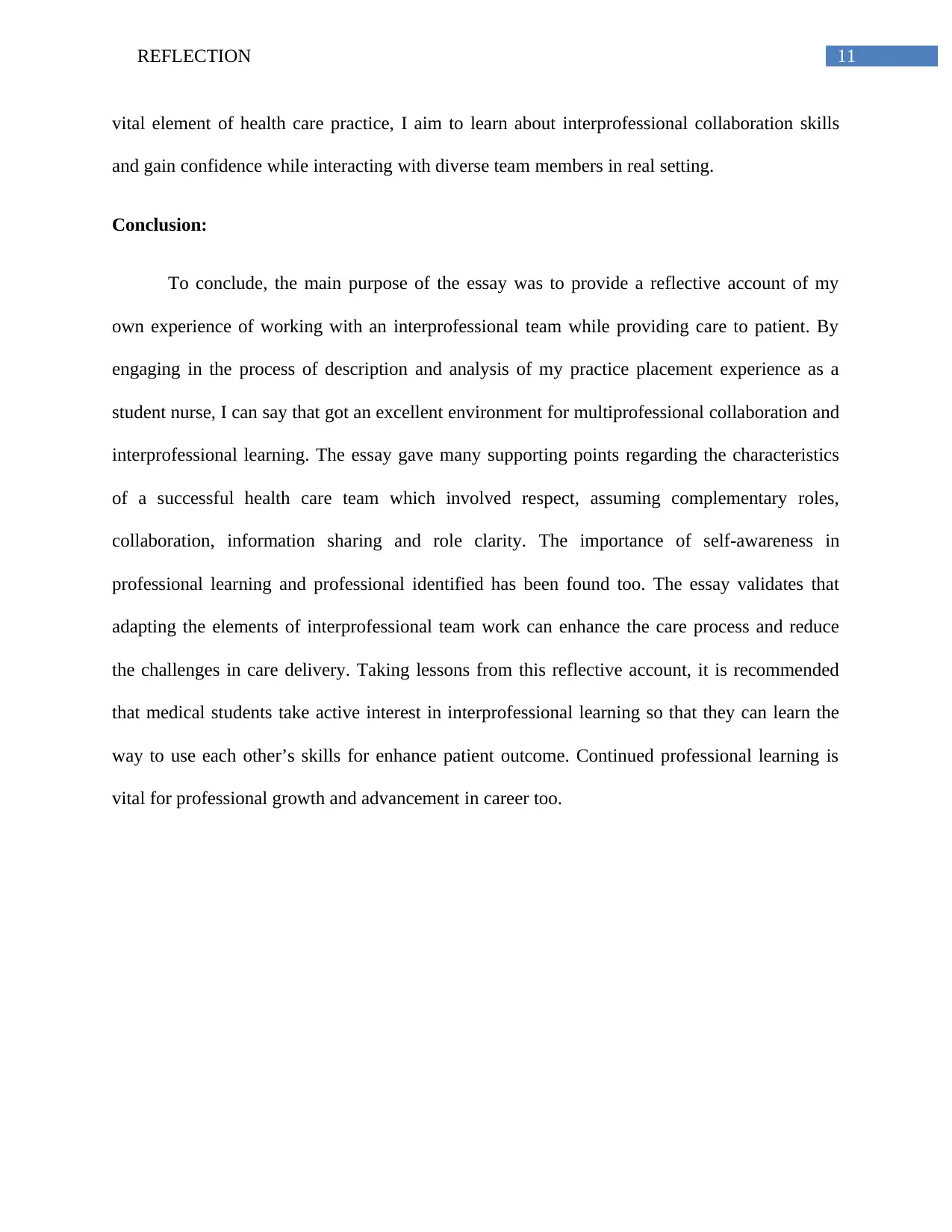
11REFLECTION
vital element of health care practice, I aim to learn about interprofessional collaboration skills
and gain confidence while interacting with diverse team members in real setting.
Conclusion:
To conclude, the main purpose of the essay was to provide a reflective account of my
own experience of working with an interprofessional team while providing care to patient. By
engaging in the process of description and analysis of my practice placement experience as a
student nurse, I can say that got an excellent environment for multiprofessional collaboration and
interprofessional learning. The essay gave many supporting points regarding the characteristics
of a successful health care team which involved respect, assuming complementary roles,
collaboration, information sharing and role clarity. The importance of self-awareness in
professional learning and professional identified has been found too. The essay validates that
adapting the elements of interprofessional team work can enhance the care process and reduce
the challenges in care delivery. Taking lessons from this reflective account, it is recommended
that medical students take active interest in interprofessional learning so that they can learn the
way to use each other’s skills for enhance patient outcome. Continued professional learning is
vital for professional growth and advancement in career too.
vital element of health care practice, I aim to learn about interprofessional collaboration skills
and gain confidence while interacting with diverse team members in real setting.
Conclusion:
To conclude, the main purpose of the essay was to provide a reflective account of my
own experience of working with an interprofessional team while providing care to patient. By
engaging in the process of description and analysis of my practice placement experience as a
student nurse, I can say that got an excellent environment for multiprofessional collaboration and
interprofessional learning. The essay gave many supporting points regarding the characteristics
of a successful health care team which involved respect, assuming complementary roles,
collaboration, information sharing and role clarity. The importance of self-awareness in
professional learning and professional identified has been found too. The essay validates that
adapting the elements of interprofessional team work can enhance the care process and reduce
the challenges in care delivery. Taking lessons from this reflective account, it is recommended
that medical students take active interest in interprofessional learning so that they can learn the
way to use each other’s skills for enhance patient outcome. Continued professional learning is
vital for professional growth and advancement in career too.
⊘ This is a preview!⊘
Do you want full access?
Subscribe today to unlock all pages.

Trusted by 1+ million students worldwide
1 out of 15
Related Documents
Your All-in-One AI-Powered Toolkit for Academic Success.
+13062052269
info@desklib.com
Available 24*7 on WhatsApp / Email
![[object Object]](/_next/static/media/star-bottom.7253800d.svg)
Unlock your academic potential
Copyright © 2020–2025 A2Z Services. All Rights Reserved. Developed and managed by ZUCOL.




